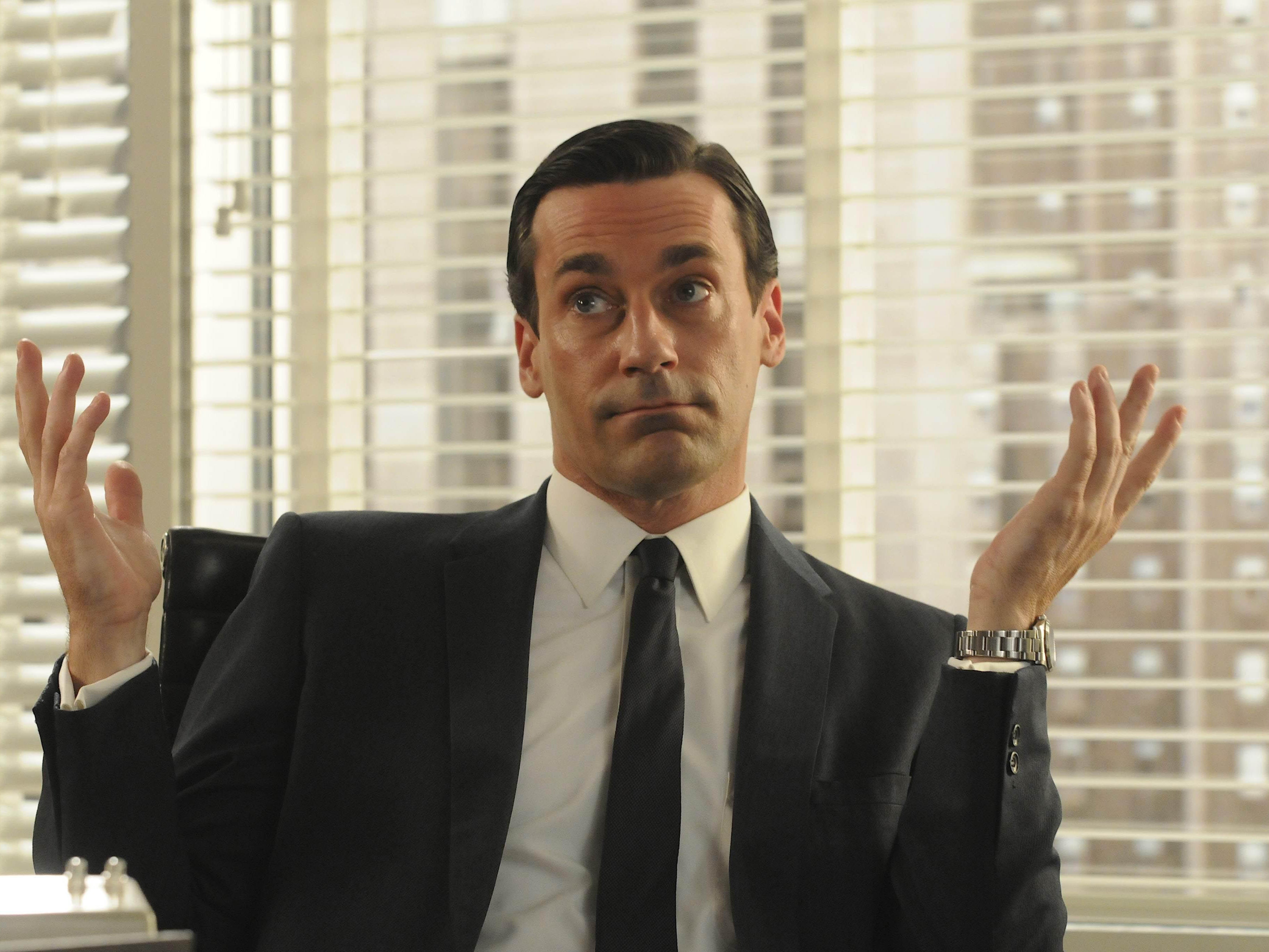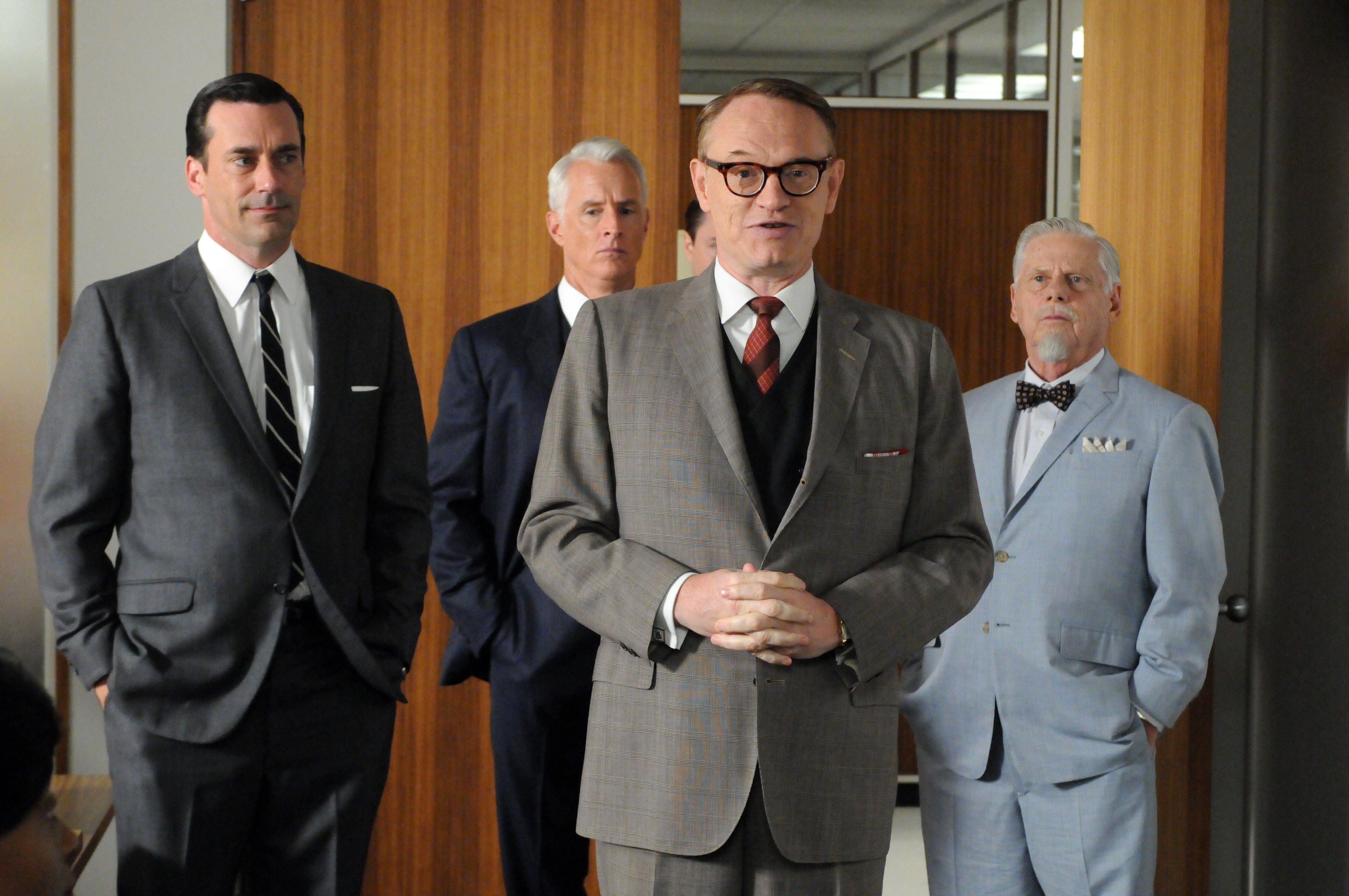Mad Men, the most visually narcotic of the prestige cable shows, slinked back into our lives – thank god – via Netflix earlier this month (the greyest, most January January I’ve personally lived through). Forget the plot for a second; from the first scene – a suited, dark-haired man sits alone at a bar, glasses clink, a waiter strikes a match to light his cigarette – we’re bludgeoned into a pleasant stupor by this hyper-saturated rendering of 1960s New York. Creator Matthew Weiner offers us a glitzy jewel of a world, so bright and colourful, so stuffed with covetable mid-century homewares, that this winter’s leaden skies and the depressing did-he-didn’t-he saga of the Nazi salute all suddenly feel very far away.
I watched the show during its initial run – the first episode aired in 2007, the final in 2015 – but haven’t revisited it until now, though it has lived somewhere in the recesses of my mind. I remember it as a particular highlight from an era when newspaper headlines regularly proclaimed that television dramas were replacing the novel as the zenith of culture.
Across seven seasons we follow the misadventures of Don Draper – grifter, womaniser and creative genius of the Madison Avenue advertising world – as he navigates the Sixties. This was the decade that saw the oppressive social conformity of the 1950s give way to the individualism of the Seventies. Sexual liberation, the feminist movement, civil rights – many of the moral codes we live by today were filtering into the public consciousness, a fact that makes Mad Men rife for “mirror to modern society” type readings.
And now, 10 years after the final episode aired, it’s the show’s exploration of the Svengali/genius archetype that I’ve found most intriguing. And in my book, Don Draper is Steve Jobs minus the polo neck.
The show starts in March 1960, the beginning of the consumer age. It’s the point in history when the public were first encouraged to see shopping as a form of self-expression. The advertising execs at Sterling Cooper, where Draper is creative director, spend much of their time selling the idea that consumers don’t choose products based on utility or effectiveness, but on how the brand makes them feel. As Don tells the owners of Lucky Strike cigarettes in the first episode: “Advertising is based on one thing: happiness. And you know what happiness is? It’s the smell of a new car. It’s freedom from fear. It’s a billboard on the side of the road that screams with reassurance that whatever you’re doing, it’s OK…”
If you’re watching the show for the first time, you may want to skip this next part. By the end of the decade, season seven of the show, Don’s out of step with the countercultural mood of the age. Kids don’t want to be told everything will be OK; they want rebellion, they want spiritual enlightenment – but how can a brand deliver that? Grappling with an existential crisis, Don finds himself unable to pitch an idea for Coca-Cola, his biggest client. A cross-country road trip leads him to a New Age retreat in California, where he’s forced to confront his own emptiness.
The show ends ambiguously, with Don seemingly finding inspiration in the commune’s ethos, which (it’s implied) he channels into Coca-Cola’s iconic “I’d like to buy the world a Coke” TV advert – since dubbed the “Hilltop” advert. Did he find any personal enlightenment at the end or was he smiling because he realised that countercultural ideals – peace, unity, love etc – can be commodified and sold as easily as the smell of a new car?
In real life, the “Hilltop” advert (which debuted in 1971 and was hugely popular) foreshadowed the modern branding strategies of companies like Apple. Writing for the website Engelsberg Ideas, the author Ian Leslie points out that “at the start of the 1970s, the Coca-Cola brand risked becoming seen by a new generation of consumers as a relic of the 1950s ... McCann Erickson’s ad ... represented a daring raid on the insurgent energy of youth culture. It was very successful. Peace and love were put in the service of sugar water, and Coca-Cola felt young again.”

Weiner was writing Mad Men in the early 2000s, just as Jobs was busy revolutionising the way we engage with and consume technology. “Here’s to the crazy ones. The misfits. The rebels. The troublemakers…” Jobs voiced Apple’s “Think different” ad campaign himself (the words wouldn’t have sounded out of place in an episode of Mad Men), versions of which ran between 1997 and 2002.
By 2007, when the first episode of Mad Men aired (the year the iPhone went on sale), Jobs was well known for turning products into cultural statements, embedding them within the fabric of self-expression. The fact that Don ends up in California, five years before Apple Computer Company was founded there, doesn’t feel like a coincidence. Whether he’s a homage to Jobs and all the genius Svengalis who came after, or a send-up, isn’t entirely clear – though it’s probably a bit of both.
Part of the joy of the show is how it manages to expose the ridiculousness of men who take themselves so seriously. The ad men are kitsch and silly – and the nature of their genius, Don’s in particular, is never entirely clear to the viewer. Some pitches may strike a chord with everyone – “It’s not called ‘The Wheel’; it’s called ‘The Carousel.’” Others, which are treated as mind-blowing within the world of the show, leave viewers scratching their heads. There’s a reason the New Yorker’s former TV critic Emily Nussbaum once called Don “a mystery wrapped in an enigma wrapped in Jon Hamm”.

Of course, it’s not a perfect show. In a scathing takedown written in 2011 for the New York Review of Books, Daniel Mendelsohn accused Mad Men of being little more than a silly “soap opera decked out in high-end clothes (and concepts)”.
Not only was it poorly written, he argued, but it also failed to properly engage with those “high-end concepts” that fooled the rest of us plebs into thinking it was cleverer than it actually was, instead picking them up in one episode only to discard them again by the next, with the carelessness of a toddler at a toybox.
And he isn’t completely wrong. Racism, sexism, gay rights: they’re explored with only varying degrees of success. In an interview with Weiner for Vanity Fair, writer Joy Press called Mad Men a “chic portrait of the fraudulence and rot beneath the Sixties” and Weiner himself explained that “the show was about my interest, to the exclusion of plot sometimes, in what it is like to be powerless”. But in many instances, the perspective is that of the rich, educated, privileged, white protagonists and how they experience the changing world.
What it does do well though is to show us the emptiness at the heart of consumerist culture – and the rapacity of the “geniuses” who sell us narratives to make us believe that we can buy our way to enlightenment. All while connecting the dots from Madison Avenue in the 1960s to Silicon Valley in the 2000s, and maybe even to the techno-authoritarian mess we find ourselves in now. And the interiors are lovely.







